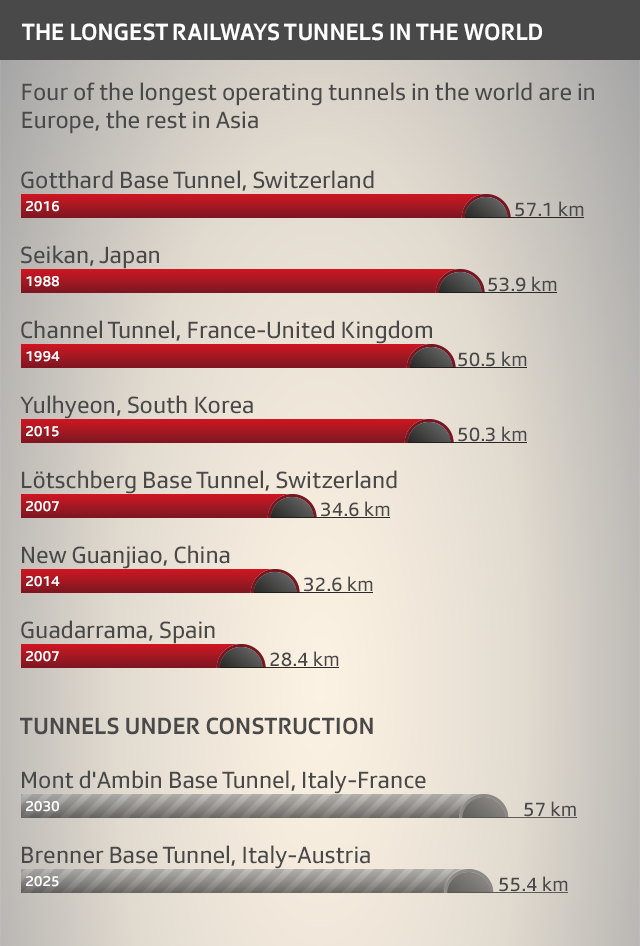The longest railway tunnels in the world
Contents |
[edit] Introduction
The world’s lengthiest railway tunnel, the Gotthard Base Tunnel (GBT) opened for business following its inauguration in June 2016. Seventeen years in construction, and a world-record 57.1 km in length, the tunnel admitted its first trains in December 2016.
Its construction was a phenomenal feat of engineering, involving around 2,400 workers and with 28.2 million tonnes of material excavated. At a cost of around 12.5 billion Swiss francs (or $12.6 in US currency), it roughly matched the budget of the London 2012 Olympics and used around 4 million cubic metres of concrete (or 84 Empire State Buildings).
Carving its way through the Alps, the tunnel was built to reduce train journey times significantly and provide a major increase in rail freight capacity.
[Image: AFP]
“It is just part of the Swiss identity,” federal transport office director Peter Fueglistaler explained to Reuters. “For us, conquering the Alps is like the Dutch exploring the oceans.”
[edit] Other terrific tunnels
The GBT overtook Japan’s Seikan Tunnel as the world’s longest underground railway passage. This in turn pushed the Channel Tunnel into third place.
The graphic below ranks the longest rail tunnels in the world, placing them in order:
[Image: Swiss Info]
[edit] Seikan, Japan
Seikan, in second place, is the oldest tunnel featured in the graphic, completed nearly three decades ago. Of its 54 km total length, some 23 km is under the sea. The tunnel connects Honshu and Hokkaido Islands in the north of Japan.
[edit] The Channel Tunnel, Europe
Linking France and the United Kingdom, Queen Elizabeth II and President Mitterrand opened the tunnel in 1994. At a final cost of £9 billion, more than 13,000 French and British workers collaborated to make the tunnel a reality.
[Image: BBC]
[edit] Yulhyeon, South Korea
The Yulhyeon Tunnel took just three and a half years to complete and is part of the Suseo High Speed Railway. The line connects Suseo Station in Seoul and Pyeongtaek 61.1 km to the south. Opened in the summer of 2015, the tunnel takes fourth place on the list.
[Image: Korea.net]
[edit] Lötschberg Base Tunnel, Switzerland
Another Swiss tunnel takes fifth place. One-third of the New Rail Link through the Alps (NRLA), alongside the GBT and the Ceneri Base Tunnel (due to open in 2020), the Lötschberg Base Tunnel opened in 2007.
[edit] New Guanjiao, China
A land-based tunnel through the Guanjiao mountains, it connects Xining and Golmud. It’s 32.6 km long and was opened in 2014.
[edit] Guadarrama, Spain
At 28.4 km long, the Guadarrama rail tunnel is part of the Madrid-Valladolid line opened in 2007. Trains can travel through it at over 310 km per hour, significantly reducing travel times.
This article was written by Joe Myers, Formative Content, World Economic Forum.
This article was also published on the Future of Construction Knowledge Sharing Platform and the WEF Agenda Blog.
--Future of Construction 10:56, 19 Jun 2017 (BST)
[edit] Related articles on Designing Buildings Wiki
Featured articles and news
Gregor Harvie argues that AI is state-sanctioned theft of IP.
Many resources for visitors aswell as new features for members.
Using technology to empower communities
The Community data platform; capturing the DNA of a place and fostering participation, for better design.
Heat pump and wind turbine sound calculations for PDRs
MCS publish updated sound calculation standards for permitted development installations.
Homes England creates largest housing-led site in the North
Successful, 34 hectare land acquisition with the residential allocation now completed.
Scottish apprenticeship training proposals
General support although better accountability and transparency is sought.
The history of building regulations
A story of belated action in response to crisis.
Moisture, fire safety and emerging trends in living walls
How wet is your wall?
Current policy explained and newly published consultation by the UK and Welsh Governments.
British architecture 1919–39. Book review.
Conservation of listed prefabs in Moseley.
Energy industry calls for urgent reform.
Heritage staff wellbeing at work survey.
A five minute introduction.
50th Golden anniversary ECA Edmundson apprentice award
Showcasing the very best electrotechnical and engineering services for half a century.
Welsh government consults on HRBs and reg changes
Seeking feedback on a new regulatory regime and a broad range of issues.
CIOB Client Guide (2nd edition) March 2025
Free download covering statutory dutyholder roles under the Building Safety Act and much more.





























